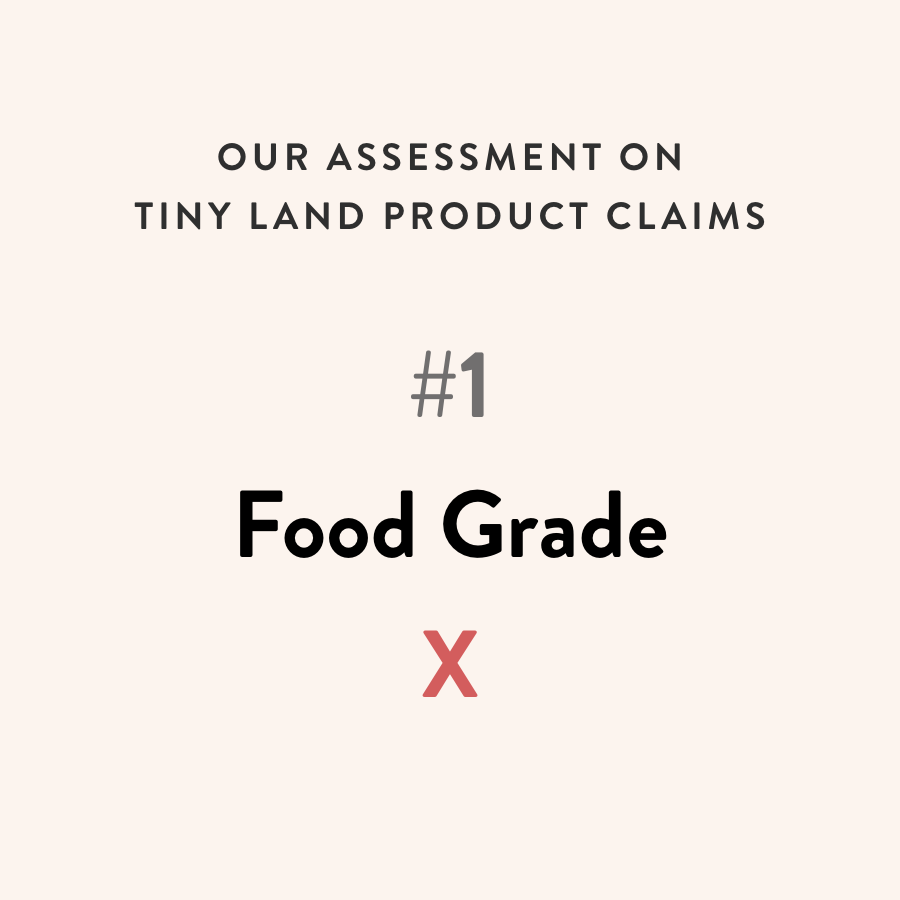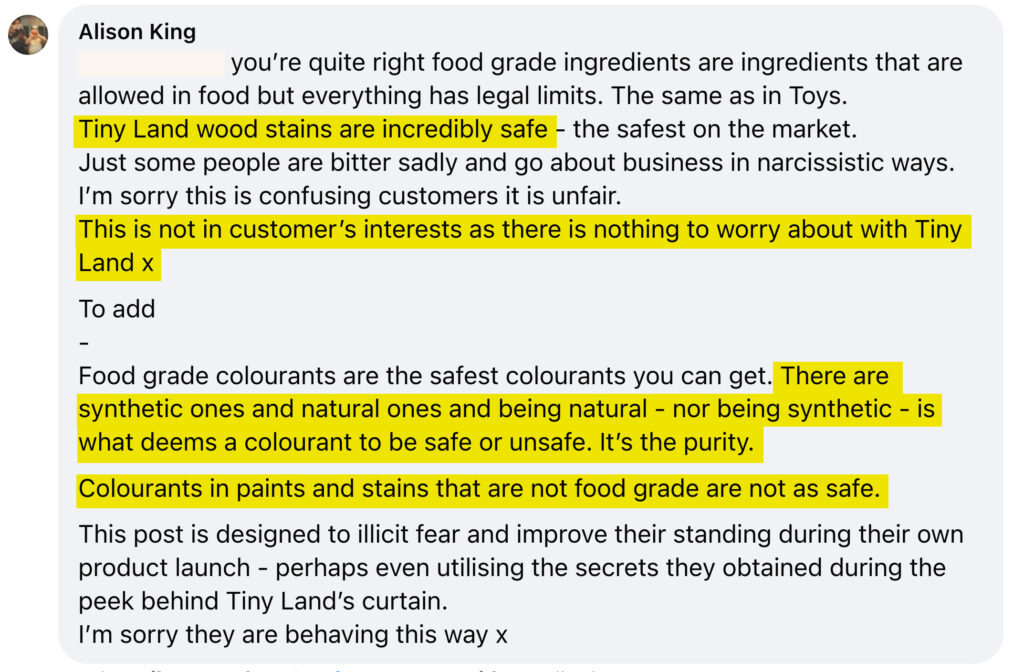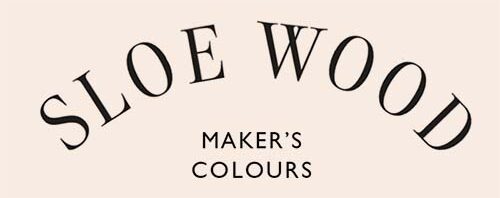Food Colourings?

In response to our article, TL is claiming that we’re liars for saying these are potentially harmful and that the synthetic food grade colourings are absolutely safe.
So, I’ll go through each point in bite sized chunks in a series of posts and pose some questions for you to consider.
#1. Food Grade claim
There are many known health hazards from exposure to synthetic colourings both through ingestion and the skin. You can find some studies in the footnotes of our first article.
Also, search for food colour toxic/food colour health risk etc on Pubmed. You’ll see hundreds of results.
The position of Tiny Land, as far as I can gather so far, is that food colourings are completely safe because of its purity. We are liars who’re only lying to unfairly damage her brand when this is of no interest of customers, and there’s ‘nothing to worry about’ for you re. their product.

Firstly, synthetic food colourings may be considered ‘pure’ in terms of their chemical composition, but the ‘purity’ is not why something is ‘safe’ unlike her claims.
She states that whether something is natural or synthetic, somehow they’re safe if it’s ‘pure’. This is simply not true.
Contaminants are harmful so you may think of ‘purity’ as one criteria for safety, but it’s not simply pure = safe.
Heavy metals, solvents like benzene, toluene, chloroform, are all ‘pure’ substances in the same way the synthetic food colourings can be chemically ‘pure’.
Pesticides, plasticisers etc are ‘pure’. Same for the natural. There are many toxic natural substances that are ‘purified’. I hope this clears up this misunderstanding.
Synthetic food colorings, even when pure’ can undergo metabolism in the body, ie. the molecules break down and become something toxic. Sensitivity and allergic reactions to even the purest food colourings are well documented. ‘Pure’ nanoparticles in food colouring are unsafe.
Has Tiny Land considered any other aspects than ‘purity’ as criteria for assessing safety?
Do you trust their claim? Do you agree with them that this safety concern we raised is of no interest to you as a customer?
Another of TL’s claims is that they’re safe just because they’re ‘food grade’.
Since the early 1980s the FDA had evidence that Red 3 caused cancer in laboratory animals. The National Toxicology Program considered the evidence “convincing.”
Yet it is still permitted in food to this day.
More over, it’s banned in Cosmetics, but allowed in Food. Does this mean that Cosmetic grade have higher standard than Food Grade? Can we just blindly assume that anything that’s officially ‘food grade’ is safe? That would encompass ALL additives certified as food grade as safe.
Do you have the same safety standard as the industry / government as a mother for your child?
If the candy manufacturer knows it causes cancer but continues using it, or they never even thought about the safety risk of what they’re using because it’s ‘food grade’, would you trust the claims of this manufacturer?
Can Tiny Land explain:
- Why is there so much published research linking them to so many & varied health risks arising from ingestion to skin contact? Do TL dispute all this research?
- Why is some of the food colouring they use banned in some countries if they’re completely safe. And why banned now when it wasn’t banned in the past?
Just one example, Titanium Dioxide is “classified by the International Agency for Research on Cancer (IARC) in Group 2B, as possibly carcinogenic to humans.
As a food additive, titanium dioxide and its nanoparticles in particular have been associated with DNA damage and cell mutations, which in turn, have potential to cause cancer.” (https://usrtk.org/chemicals/titanium-dioxide/)
Did TL use Titanium Dioxide in large quantities in the past in their playdough for children under 3 to use?
Was it not a potential carcinogenic prior to the 2022 ban, but it is now?
What is their actual criteria for ‘safe’ other than it being ‘food grade’ and ‘pure’?
The FSA in the UK recommends that manufacturers avoid synthetic food colouring even if they’re permitted. They’re not allowed in any amounts for children under 36. Because they’re not considered ‘safe’.
Why is that there’s nothing to worry about the potential exposure?
Can they explain in more detail why the customers shouldn’t question their safety claims? (Instead of just saying ‘it’s food grade and pure so it’s safe’ – because this kind of statement makes us doubt that she understands how to assess the safety of the particular product for each use case.)
We published our article because we did not like what we found. We gave the benefit of the doubt and expected Tiny Land to at least address some of the health concerns, if not all, and caution their customers.
So far, we’re just called a liar : )
Questions for you:
- Would you prefer for the brand to give you some safety cautions and explain the potential risks to you when you use those products containing controversial substances?
- Considering the widely known controversy, would you trust a brand who insists that there’s nothing to worry about whatsoever re. their product containing these substances?
- If a brand doesn’t seem to acknowledge any controversy or health risks at all and instead call the critics liars, do you think they’re doing their best to ensure customer’s safety?
- When you buy ‘food grade’ / ‘safe to eat’ products and your under 3 year old baby’s been exposed to it by occasionally eating, or long skin exposure as when using finger paint, would you be ok to find out the following later?
- That they are actually completely banned for food for under 3 years
- That they are banned in your country for not being safe, if you bought the product from abroad
- That some of them are banned from this year and turned out to be linked to DNA damage
Our point
It is much more beneficial to inform customers of potential risks and help them to use the products more responsibly, rather than encouraging them not to worry about it at all and ignore the ongoing research.
Small businesses should set better standards than government/industry standards to gain trust from customers.
As ‘food grade’ and ‘safe to eat’ claims tend to make customers ‘relax’ about their usual cautions, we think it can cause more harm.
Also, considering the outright ban for under 36 months and in many other countries, it is simply misleading to convince many customers to believe it is all permitted and safe, when they may be using a banned substance in many cases.
Some Tiny Land’s supporters said we’re a complete liar for bringing up this issues.
If you think we shouldn’t tell the customer/public about these information, can you tell us the reason? It is because it’s ‘designed to illicit fear’ as TL claims?
Would you rather know about the health risk and make sure your family is safe, or rather not know about it?
What do you think? : )
[Re her comment ‘colourants in paints and stains are not food grade and not safe’. There’s a confusion and misunderstanding in what she says here, but we’ll address it in another post]
